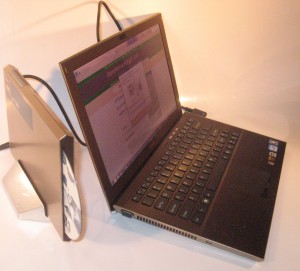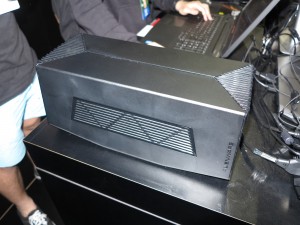Article
Here’s The Box That Can Turn a Puny Laptop Into a Graphical Powerhouse | Gizmodo
My Comments
There have been some successful attempts at developing outboard expansion modules or docking stations that add discrete graphics or a better discrete-graphics solution to a laptop computer which wouldn’t have internal room for this kind of performance.
One of these was Sony with their VAIO Z Series that I reviewed previously which had an expansion module that housed a Blu-Ray drive and an AMD discrete graphics chipset. This used an Intel “Light Peak” connection (Thunderbolt over USB) between the devices to provide for high data throughput between the host computer and the expansion module.
Another of these was one of the new Alienware gaming laptops that could connect to a so-called “Graphics Amplifier” which was an expansion module for some of the Alienware R2 series gaming laptops that could house one or two PCI-Express graphics cards. This brought forward the idea that a laptop could have desktop gaming-rig performance just by adding on an expansion module.
Both these solutions implemented manufacturer-specific connection methods which restricted which devices can connect to these “external-graphics” expansion modules.
But the USB 3.1 standard with the Type-C connection allowed the same connection to be used to connect other devices via different logical connection methods like Intel’s Thunderbolt. This was effectively “opened up” as a high-performance connection for expansion modules when Intel launched “Thunderbolt 3” which has throughput equivalent to what happens on a computer’s motherboard.
This led to some reference designs being presented at the Intel Developers Forum 2015 for external-graphics docks of the Sony VAIO Z or Alienware Graphics Amplifier ilk that are able to work with laptops that have the USB Type-C and Intel Thunderbolt 3 connection. In their own right, they are expansion modules which add extra connectivity to the laptop but also they give it access to improved discrete graphics chipsets. One of these was modelled on the Alienware Graphics Amplifier by virtue of allowing the use of fully-fledged graphics cards of the kind expected in that tower-style gaming rig.
The equipment that was shown proved the concept that you could use Thunderbolt 3 over a USB 3.1 Type C physical connection to provide an external discrete-graphics solution for an ultraportable laptop computer or similarly-small computer design. This proves that it can be feasible to use these modules for an “at-home” or “at-office” solutions where performance is desirable but allow for a lightweight computer system.
Similarly, a manufacturer could offer a laptop or all-in-one desktop with the integrated graphics but allow their customers to buy a graphics expansion module at a later date should they want something with more graphics acumen. Here, they can simply plug in the graphics expansion module and play rather than opening up the computer to install a graphics card. There is also a reality that as newer graphics chipsets come along, the person can purchase a newer expansion module or, in the case of those units that use PCI-Express desktop cards, install a newer graphics card in to the module to take advantage of these newer designs.
It simply underscores that fact that USB 3.1 Type C opens up the concept of expandability for tablets, laptops, all-in-one and small-profile desktops even further by use of external modules that offer different functions to suit different needs at different times.





